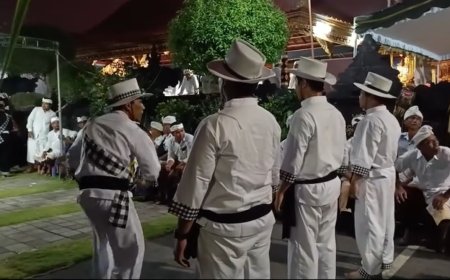Griya Tanah Kilap Temple: The Form of Cultural Acculturation between China and Bali
Combining the grandeur of Chinese cultural aesthetics with the traditional beauty of Bali, this temple is a unique embodiment of a captivating cultural fusion. Discover the secrets and charm behind the striking red pillars of Griya Tanah Kilap Temple.

The island of Bali is indeed renowned for its unique and fascinating culture. One of the main attractions for both local and international tourists is the presence of thousands of temples scattered throughout the island. These temples have a captivating history and architectural design that never fails to capture the attention of visitors.
One of these temples is Griya Tanah Kilap Temple, located in the Pemogan area, precisely at Griya Anyar street no. 104, Banjar Gelogor Carik, South Denpasar, Bali. Its central location within the city makes this temple easily accessible for both tourists and locals to visit and pay their respects.
Tanah Kilap Temple is divided into several places in its surrounding area, namely, Griya Tanah Kilap Temple, Luhur Candi Narmada Tanah Kilap Temple, and Griya Kongco Tanah Kilap. According to reviews from visitors on the website tripadvisor.co.id, they mentioned that the presence of Kongco in this temple is what catches their attention there, mainly because of the red color of lanterns hung around, which sets its design apart from other shrines.
When you visit this place, you will be presented with the main shrines of Griya Tanah Kilap Temple. These include the shrine of Ida Ratu Bhatara Niang Sakti, and to the west, there are the shrines of Ratu Bhatari Mas Melanting, Ratu Ida Bhatara Segara, Ratu Sang Hyang Siwa Baruna, and the Taru Agung Ratu Mas Manik shrine. To the south, you will find the shrine of Ida Ratu Gede Dalem, right next to it is the Kongco shrine, which was built in 2011.
Behind its unique and artistic visuals, Griya Tanah Kilap Temple holds a history with equally intriguing tales from the past. From the appearance of the mysterious old lady to the challenges faced during projects in the area. How the Kongco came to be in this temple and the reason it's named "Tanah Kilap" will be explained by a speaker who is closely connected to the founder of Griya Tanah Kilap Temple.
The construction of Griya Tanah Kilap Temple, according to the testimony provided by a reliable source from youtube channel called "Bali Berbudaya", Anak Agung Aji Alit Mangku, who serves as the caretaker and priest of Griya Tanah Kilap Temple today. He is also the child of the late Anak Agung Made Suardana, who was the pioneer behind the establishment of Griya Tanah Kilap Temple in 1962.

Griya Tanah Kilap Temple (Source Photo : Koleksi Redaksi)
While waiting for passengers at Kuta market, the late individual unexpectedly encountered an elderly lady who was aware of their neck ailment. The lady offered a remedy and invited them to her residence. The individual was surprised but driven by strong curiosity, decided to follow the lady to the Pemogan area. They walked until they reached the broken bridge. At the end of the bridge stood a Santen Wood Tree pointed out by the lady. While the individual was gazing at the tree, the figure of the lady had mysteriously vanished. The individual continued to think about this encounter until they met again in a dream, where they made an agreement that if the individual were to be healed, they would be willing to assist in managing Griya Ratu Niang.
The process of 'ngatur ayah' for Griya Ratu Niang follows a specific path at various distinct points in the surrounding area. The first point is beneath the Santen Wood Tree, where there's a cave-like hole beneath its roots. Then, there's the Telagi Tree, not far from there, followed by the Sambung Tulang Tree near the factory. The last location is a Punyan Kayu Sugih tree situated in a hollow when the water recedes in the late afternoon. Surrounding it are graves and a stone inscribed with Qing Dynasty script. This stone has been worshipped in the Buddhist manner, following the era of Siwabudha, and has become the Kongco. Finally, the journey returns to Griya Ratu Niang at the Santen Wood Tree.
Over time, the late individual gradually developed Griya Tanah Kilap, and coincidentally, during that period, the government was working on a bridge construction project that faced persistent challenges. The late individual then suggested to the government to perform a 'materuning' ceremony at Griya Ratu Niang to ensure the smooth progress of their project.
In 1986, the government provided financial assistance to support the financing of Griya Ratu Niang, and this also led to the official recognition of Griya Tanah Kilap Temple by the Parisadha Hindu Dharma and the Nusa Penida Bali Water Department. This support allowed the bridge construction project to proceed without obstacles.
Griya Tanah Kilap Temple has since expanded from 60 square meters to its current size of 17.8 hectares. The name "Tanah Kilap" was not given without reason, it was named so because the soil around the construction of Griya Ratu Niang was black and shimmered when exposed to sunlight. Therefore, the late Anak Agung Made Suardana patented the name "Tanah Kilap" as the name for the residence of Ida Bhatara Ratu Niang.
This cultural fusion began accidentally when a Qing Dynasty stone inscription was discovered during the 'ngatur ayah' process and has continued to evolve. Today, in Kongco, many Hindu and Confucian devotees come to worship, especially during the full moon.






























































